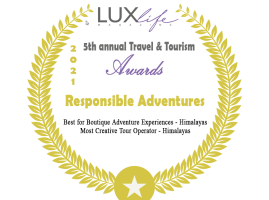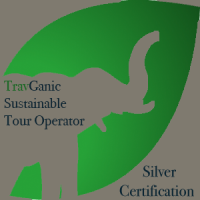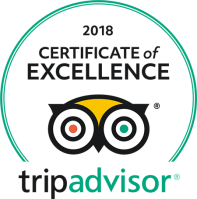Wellness Adventures in the Himalayas
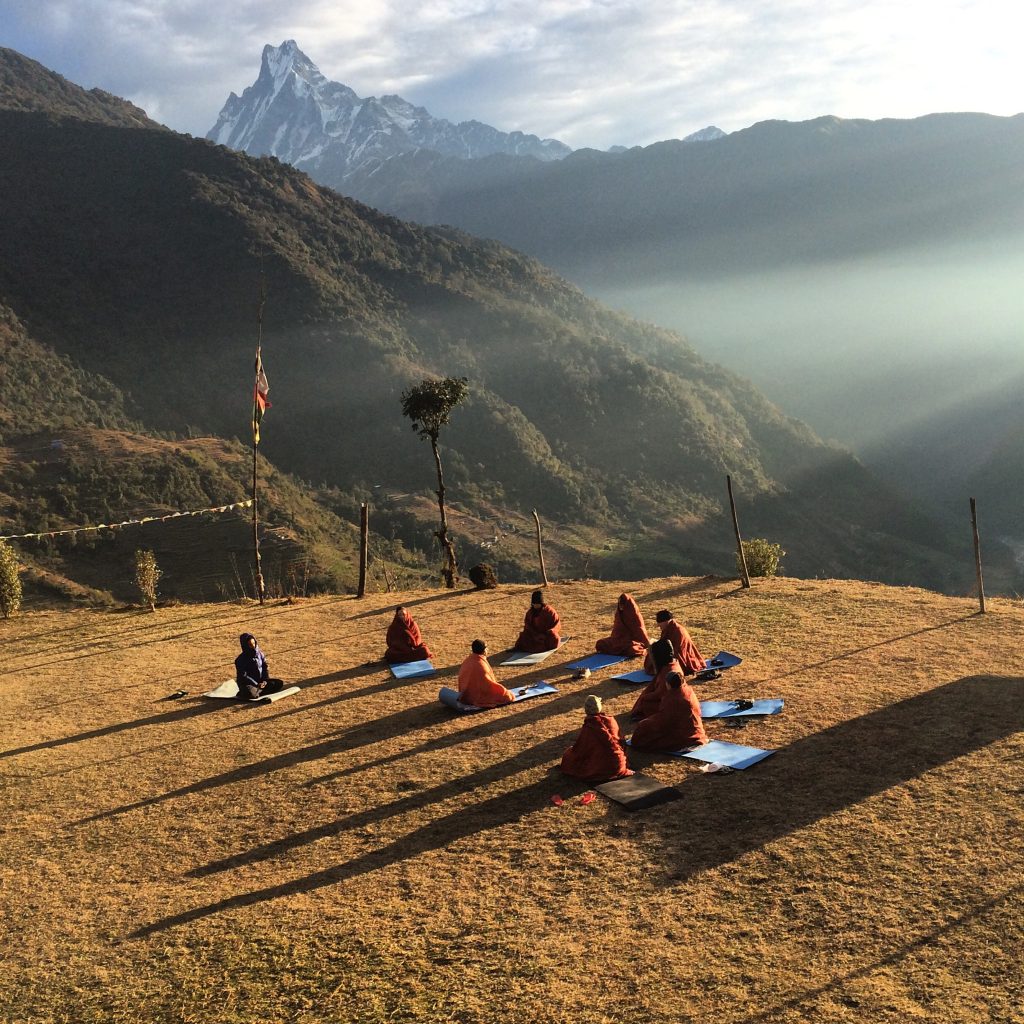
Wellness Adventures in the Himalayas Embark on a unique journey of Wellness Adventures in the Himalayas with a twist that sets it apart from traditional wellness experiences. At Responsible Adventures, we believe that true wellness goes beyond pampering at luxury spas and resorts. Our Wellness Treks offer a unique experience combining moderate to challenging hiking levels with mindful practices, nourishing food, and a deeper connection to the natural world. These treks are designed to be accessible to individuals with moderate fitness levels and can be tailored to accommodate different fitness levels. Our Wellness Treks provide a holistic experience that nurtures both body and mind. We move away from the commercialised view of wellness and focus on the fundamental elements that genuinely promote well-being. By immersing trekkers in the stunning landscapes of the Himalayas, we offer a unique chance to escape the pressures of modern life and rediscover what truly matters. Nutrition plays a crucial role in our Wellness Treks. Our trekking chefs, trained in high-altitude cooking and nutrition, use superfoods and nutrient-rich ingredients to ensure that meals are delicious and highly nourishing. This approach helps trekkers maintain energy, recover quickly, and acclimate to high altitudes. Our thoughtfully planned meals support overall health, proving that simple, wholesome food can be enjoyable and functional. The Himalayas provide an unparalleled setting for reconnecting with nature. Our treks take you far from the chaos of everyday life and immerse you in the serene beauty of the mountains. Trekkers are encouraged to slow down and absorb their surroundings through guided mindfulness practices, nature walks, and quiet reflection. This connection with nature helps reduce stress, sharpen mental clarity, and foster a deep sense of peace and gratitude. At the heart of our Wellness Treks is a return to basics. We ignore the excess and focus on the essentials: fresh air, physical activity, good company, and simple, nourishing food. By simplifying the experience, we create space for trekkers to reconnect with themselves and appreciate the fundamental joys of life that are often overlooked in the hustle of modern living. Wellness isn’t confined to luxury treatments; it’s a lifestyle. During our treks, we educate our clients on the broader concept of wellness—beyond the confines of upscale resorts and spas. We discuss the importance of balance, mindfulness, and connecting with nature as key elements of a healthy life. Our guides offer practical tips on integrating these principles into everyday routines, making wellness accessible and sustainable for everyone. Our treks are intentionally paced to allow for mindful hiking, enabling trekkers to connect with their surroundings and themselves. We incorporate moments of reflection, meditation, and breathing exercises, helping trekkers centre themselves and fully engage with the journey. This mindful approach turns the trek into a meditative experience, enhancing the sense of presence and connection. Wellness also means connection—both with oneself and others. Our Wellness Treks cultivate community among participants, creating a supportive environment where individuals can share experiences, learn from one another, and build meaningful connections. Trekking together, sharing meals, and participating in group mindfulness activities form bonds that often extend far beyond the trail. We aim to redefine the concept of luxury in wellness by highlighting the richness of simple, authentic experiences. The luxury we offer isn’t found in opulent accommodations or elaborate treatments but in the genuine, unfiltered experiences of nature and self-discovery. Our Wellness Treks are about finding joy in simplicity, embracing the raw beauty of the Himalayas, and experiencing the freedom that comes from disconnecting from the digital world and reconnecting with the real one. Wellness at Responsible Adventures goes beyond pampering; it’s about fostering a balanced lifestyle, reconnecting with nature, and rediscovering the basics. Combining hiking, nature, and mindful practices, we offer a transformative experience that touches the core of being truly well. Join us on a Wellness Trek and explore a different kind of luxury that rejuvenates body, mind, and spirit in the heart of the Himalayas.
Innovative, Responsible and Sustainable Trekking Adventures in the Himalayas and beyond
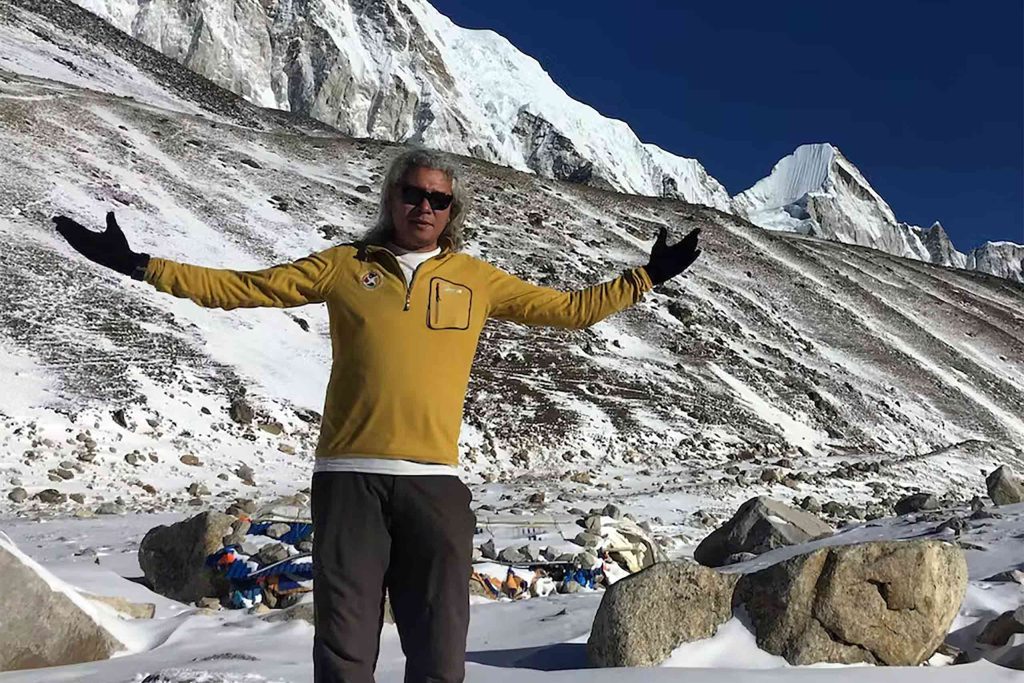
Innovative, Responsible and Sustainable Trekking Adventures in the Himalayas and beyond Raj Tamang is not just another trekking guide in the Himalayas—he’s a pioneer, a mentor, and a true advocate for responsible tourism and community empowerment. With decades of experience and a unique approach to guiding, Raj stands out among his peers for his dedication to creating meaningful, sustainable, and transformative trekking experiences. Here’s how Raj Tamang differs from other trekking guides and tour leaders in the Himalayas: 1. A Pioneer in Wellness Trekking He has redefined the trekking experience with his concept of Wellness Trekking. Unlike traditional treks focusing solely on the physical challenge, Raj incorporates wellness, mindfulness, and holistic health elements into the journey. He has trained trekking chefs to use superfoods and nutritious ingredients, ensuring that trekkers are well-fed and nourished to support acclimatisation and recovery. This innovative approach enhances the trekking experience, allowing trekkers to reconnect with nature and appreciate the journey on a deeper level. 2. Commitment to DEI and Empowerment He passionately advocates for diversity, equity, and inclusion (DEI) in Nepal and globally. He actively works to empower marginalised communities by providing fair employment opportunities and promoting the importance of DEI in every training session, workshop, and conversation he leads. Raj’s commitment to uplifting others sets him apart as a leader who truly cares about the people he works with and the communities he serves. His efforts go beyond trekking; they’re about making a lasting positive impact on society. 3. Extensive Training and Expertise Raj’s expertise extends far beyond the trails. He has trained numerous trekking guides and leaders for Responsible Adventures and other companies in Nepal, India, Pakistan, and Tanzania. He will be conducting training for adventure guides/leaders in Uzbekistan in 2025. His training programs include advanced wilderness first aid, leadership skills, and customer service, ensuring that the guides he trains are well-prepared to handle any situation on the trek. Raj’s dedication to excellence in guiding has set a high standard in the industry, making him a respected mentor and leader. 4. Personalised and Ethical Approach Unlike many guides who might take a more commercial approach, Raj is deeply involved in every aspect of his treks. He handpicks his support crew, ensuring they are treated with respect, paid fairly, and provided with the proper gear and training. Raj doesn’t subcontract others to select porters; he believes in building a team that shares his respect, care, and commitment values. This personalised approach ensures high standards and creates a close-knit, supportive environment for his team and trekkers. 5. Deep Cultural Insight and Storytelling Raj’s extensive knowledge of the Himalayan culture, history, and traditions adds a unique dimension to his treks. He is not just a guide but also a storyteller, sharing rich insights and local legends that bring the landscapes to life. His deep connection to the region allows trekkers to experience the Himalayas in a way that goes beyond the surface, offering a deeper understanding and appreciation of the people and places they encounter. 6. Dedication to Responsible and Sustainable Tourism As the founder of Responsible Adventures, he has built his company on sustainable and responsible tourism principles. He leads by example, minimising environmental impact, supporting local economies, and educating trekkers about the importance of protecting the natural and cultural heritage of the Himalayas. His commitment to sustainability is not just a business model; it’s a way of life that he passionately promotes at every opportunity. Responsible Adventures offers all fully carbon-neutral tours. The company works with Offset Alliance to offset the carbon emissions from all its trips, making the treks environmentally accountable. This commitment includes planting trees and adopting sustainable practices to ensure a minimal ecological footprint. Responsible Adventures’ founder, Raj Tamang, also integrates carbon-neutral travel into his personal journeys, aligning with the company’s broader mission of promoting sustainability in tourism. 7. A Personal Touch and Genuine Care What truly sets Raj apart is his genuine care for the well-being of his trekkers and team. He goes above and beyond to ensure everyone feels supported, valued, and safe throughout the journey. His leadership style is characterised by empathy, attentiveness, and a personal touch, making every trek feel like a shared adventure among friends. Raj’s ability to connect with people personally creates an inclusive and encouraging environment where everyone can thrive. 8. A Visionary with a Global Impact Raj’s influence extends beyond the Himalayas. His vision for responsible tourism and community empowerment has taken him around the world, where he continues to spread the importance of DEI and ethical practices in the tourism industry. Raj’s work has inspired many to rethink their approach to travel and guiding, making him not just a leader in the Himalayas but a global ambassador for positive change in the trekking community. 9. Ultra High-end Adventures in the Himalayas. It’s a common belief that only the ultra-rich can travel on their private jets. However, many people don’t realise that regardless of wealth or aircraft sophistication, pilots must be qualified to land or take off at high altitudes and narrow valleys of destinations like Leh, Ladakh, Paro, and Kathmandu. These qualifications are not just a formality but a crucial aspect of flying. Understanding this can make you more informed and knowledgeable about the aviation industry. Raj can hire small private jets managed by qualified pilots to fly in and out of destinations such as Leh, Paro, and Kathmandu. He can design a private jet and helicopter tour to see the highest peaks in Ladakh, Bhutan, Nepal, and Pakistan.” Raj Tamang is available for hire to lead private groups on unforgettable trekking adventures across the Himalayas and beyond. With over three decades of experience, Raj has led numerous treks through challenging terrains in Nepal, Tibet, Bhutan, and India. He also has international expertise, having recently guided a group of Singaporeans to the summit of Mount Kilimanjaro in Tanzania. Known for his personalised approach and
Top Tips for being a Responsible Hiker
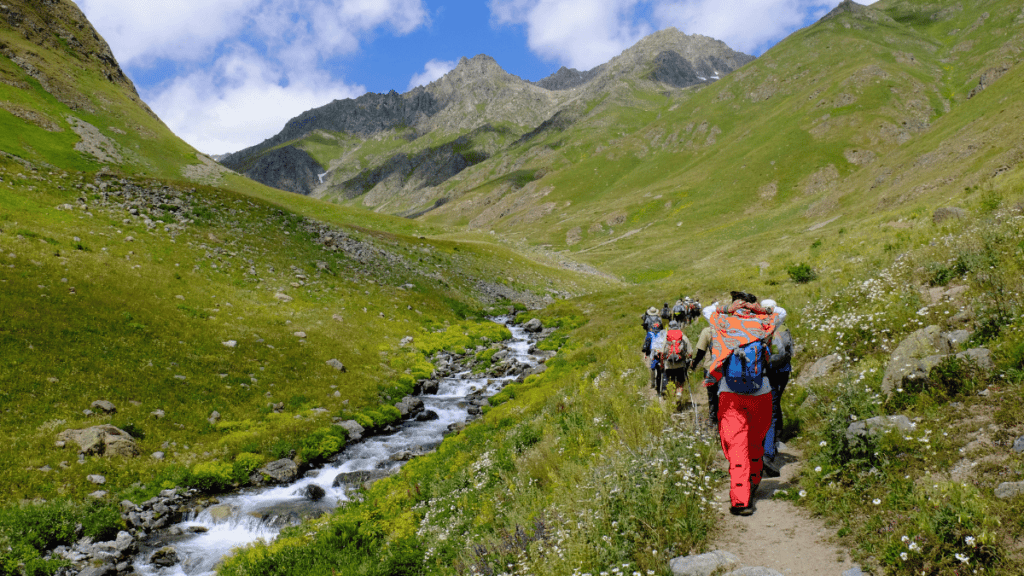
Top Tips for being a Responsible Hiker Many of us plan holidays to experience new corners of the world, and what better way to do that than exploring the local area on foot? With so many incredible hiking trails to discover, it’s no wonder that many people visit the beautiful sites in person. However, as a hiker, you must ensure that you’re respecting the local area. Irresponsible hikers can harm the local environment and the community, so trying to minimise your impact as much as possible is essential. Keep reading for helpful tips to ensure you sustainably enjoy your next hike. Limit single-use products Before you rush into your next adventure, ensure you’re appropriately prepared. This means bringing all the equipment you could need for your hike, including a reusable water bottle, to reduce the waste you produce. Disposable plastic water bottles are a common issue, particularly where hiking trails are concerned. Although drinking plenty of water on a hike is essential, plastic water bottles are not the answer. Many hiking trails are becoming littered with them, threatening the local wildlife. Instead, bring a large bottle with you and refill it at the designated points, or use a bottle with a filter and drink straight from any approved streams or rivers nearby. Take your rubbish with you. Some products will inevitably produce some waste, such as snack wrappers or cigarettes, but resist the temptation to discard them on the trail. As with plastic bottles, wrappers can not only become an eyesore in an otherwise beautiful area, but they can also harm the local wildlife. Ensure you bring any rubbish off the trail instead, where it can be disposed of appropriately. It is even better if recycling facilities are available, further reducing your impact. Don’t interact with wildlife. Hiking trails are often located in areas with unique wildlife, making them particularly attractive locations. However, these ecosystems are fragile, so it’s essential to be mindful of the impact we can have. Please resist the temptation to feed any of the creatures you encounter, as it can disrupt the food chain, leading to population changes and potentially endangering other wildlife. Similarly, don’t touch any local wildlife. Although they may seem harmless, touching them can present a danger to both the animal and you. Being a responsible hiker is about treating the areas you visit with the same respect that you would your home. These stunning locations should be protected from harm, kept clean and left as they were found to ensure that future generations can enjoy them as we do. Not only that, but it’s essential to respect the local community during your visit. After all, they live there year-round; the least we can do is preserve the beautiful trails during our visits.
7 Challenging Trekking Trails in Nepal
7 Challenging Trekking Trails in Nepal There is something quite intriguing about exploring the unknown. Traversing rugged terrain is very popular, and some of the most challenging environments are found in proximity to mountainous regions. Nepal, the Himalayan nation, has always been a popular destination for trekkers – amateurs and pros alike. While most people may equate Nepal with the expedition to conquer Mount Everest (as seen in the 2006 documentary Everest: Beyond the Limit on Prime Video), the country offers a great variety of treks to other not-so-intimidating-yet-challenging areas. If you’re all prepared to take the next step, then the information below can guide you to some of the best Nepal trekking regions. Due to the difficult terrain, some of these routes are recommended only for experienced trekkers. 1. Manaslu Circuit Trekking (Image: “ManasluCircuit4.jpg” by Spencer Weart licensed under CC BY-SA 3.0.) The Manaslu region is located in west-central Nepal and is one of the less-visited regions of the Himalayas. Basic infrastructure is minimal as you go around Mt. Manaslu, the eighth-highest mountain on earth. Manaslu circuit trekking is possible even though many parts of the area have yet to be explored. Individuals have come here since the early 1990s, thanks to the pristine wilderness. The mountain’s peak crests at 8,156 meters. The trail goes around the Manaslu Conservation Area, which is home to rare animals and birds.
Partnership of LGBTQ+ Tour Operators and Nepal Adventure Travel Company
Partnership of LGBTQ+ Tour Operators and Nepal Adventure Travel Company Responsible Adventures Boutique trekking with a unique culinary experience for all genders and age groups. LET’S WORK TOGETHER At Responsible Adventures, a leading adventure company in Nepal, we seek professional partners to offer unique adventure tours to the LGBTQ+ community. We have had great success in the past with ‘women only’ tours and know that everyone enjoys these tours being with like-minded people. We also add a unique twist to our tours, with a specialist chef accompanying each tour, creating gastronomic delights at the end of each day. Special dietary requirements are catered for. During webinars and interviews, John Tanzella mentioned that the LGBTQ+ community would lead the way when tourism restarts and the rest follow! We have learned that 99% of the LGBTQ+ Tour operators and Travel Advisors don’t offer Trekking Adventure vacations. This is lost revenue for both of us. With a solid professional partnership, we can offer Adventure vacations to your clientele who would otherwise book with non-LGBTQ or Ally tour companies. What we offer We specialize in off-the-beaten-path treks that are not overcrowded with tourists (there are only known to very few trekking companies) We provide an innovative culinary service using nutritious and locally produced ingredients. Also, we serve the most varied and healthiest meals in the Himalayas. We aim to bring LGBTQ+ customers to beautiful and exotic locations and let them experience the culture. Here is our travel guide for LGBTQ+ Travellers to Nepal Responsible Adventures is a leader in innovative boutique adventure tours that are ‘Out-of-the-box’ unparalleled lifetime experiences. We have pioneered luxury mobile camping and culinary trekking adventures in the Himalayas. We strive to provide our customers with a successful and adventurous journey. Be assured of an upgraded service with the utmost attention to detail, a step above a traditional adventure holiday. What are we looking for We are looking for a tour company willing to partner with an eco-friendly company like ours and give the LGBTQ+ community an option to visit the Himalayas and other attractions in Nepal. Trekking is for everyone! We have handled trekkers from the age range of 3 to 77 years old! And if you don’t feel like trekking, there are options like wellness, yoga or an exciting chartered helicopter flight to the Himalayas. We are eco-friendly and sustainable, with a solid commitment to empowering marginalized communities. As part of this commitment, we provide a complimentary one-hour “Trekkers’ massage” by visually impaired masseuses at the end of each trekking package. Let’s join hands and provide your clients with unmatched trekking adventures in style. Let’s kickstart tourism together. The reopening of tourism brings a tremendous opportunity for us both. People of all ages and genders will get to travel again, and we want to be in the centre of it. We are Allies and members of the IGLTA.
The History of Trekking in Nepal
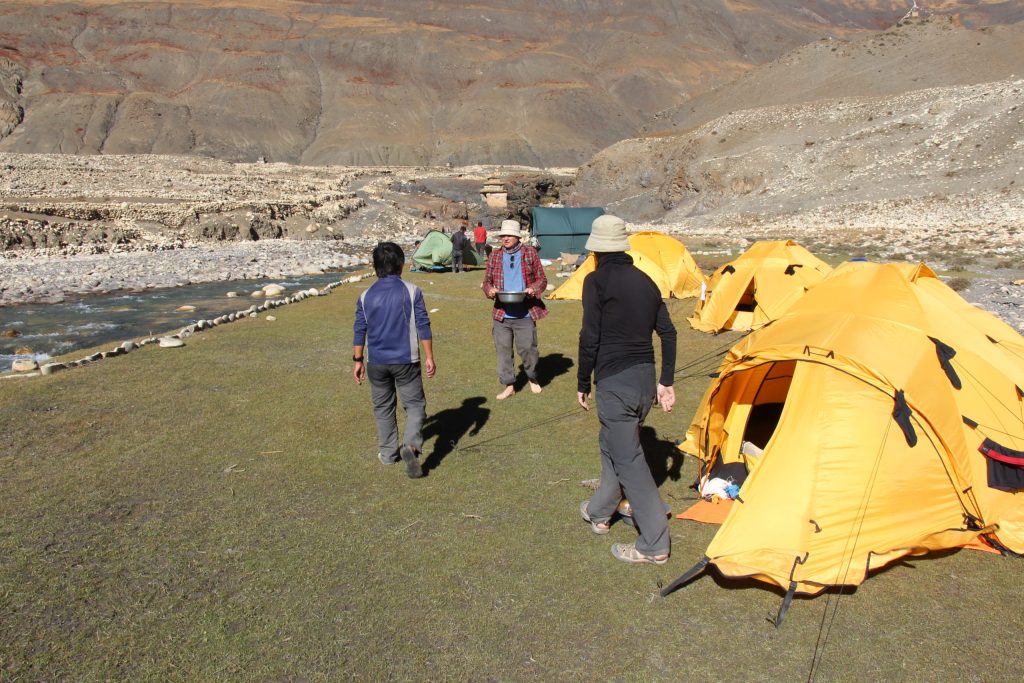
The History of Trekking in Nepal The word trek was adapted from the Afrikaan’s word trekken, which means to haul or pull. So the Dutch settlers of South Africa spoke it. It means a long, challenging journey. The Nepalese had been walking to get anywhere in this mountainous nation for several centuries. Enchantment with the mountains has existed in humankind for as long as it can be remembered. Nepal’s trekking history began with mountaineers’ teams who came on expeditions to climb the majestic peaks. Nepal became known as a trekkers’ paradise when British adventurer Bill Tilman managed to get permission from the then King to go on several treks in 1949. He explored the Kali Gandaki, Helambu, and Everest regions. Maurice Herzog was another early visitor to Nepal. He led a successful French mountaineering expedition on Mount Annapurna 8091m. The Americans in 1950 and the British in 1951 led mountaineering expeditions to Mount Everest. Colonel Jimmy Roberts, a retired Gurkha Officer and a Military Attache at the British Embassy in Kathmandu saw great potential in trekking as a business. He had spent a great many years hiking in the hills of Nepal. He even accompanied Tilman on his first exploratory trek. As a result, Jimmy Roberts founded Mountain Travel, Nepal’s first trekking company, in 1964, giving birth to Nepal’s mountains’ commercial adventures. His idea was revolutionary for that era. The trekking expeditions were done in a fully supported camping style. The clients were accompanied by a Western leader and a Sherpa support team from a Sirdar (foreman), his assistants, a cook, kitchen boys, and numerous porters to carry all the camping equipment and food. This trekking style in Nepal made it a luxurious experience and possible for a more adventurous to whom the price was no object to visit Nepal in ‘comfort.’ Mountain Travel remained Nepal’s only trekking company until 1968. The first commercial trekkers were three American ladies who were expatriates in Calcutta. These ladies were a sporting trio of enthusiasts, according to Jimmy Roberts. He was joined by Mike Cheney and Dawa Norbu Sherpa at Mountain travel. Sir Edmund Hillary stated, “Nepal is the only country in the world which is also one of the world’s great trekking paradises and one of the nicest countries in the world for trekking.” His overseas pioneer partners were Allen Steck, Barry Bishop, and Leo LeBon from the U.S.A and Australian Warwick Peacock, the owner of “Ausventure.” They began sending clients from their respective nations regularly to trek in Nepal. Mountain Travel inspired other tourism entrepreneurs when their business prospered; this was the beginning of more trekking and adventure companies starting in Nepal. Trekking is famous as it is less taxing physically than mountaineering. It was not easy in those days, but they managed to lure the rich and the famous into this mysterious and remote Kingdom with vivid imagination and creativity. Despite the disadvantages of using telegram, and crackly telephones, Nepal became trendy and a sought-after destination for American and European adventurers. Nepal became a regular visiting destination for superstars and celebrities as they could enjoy privacy in the peace of the mountains of Nepal and away from the media coverage. At Responsible Adventures, we have been working on innovative and pioneering ideas to keep this tradition alive to provide exceptional experiences to the trekkers who value their trekking vacation. Some quotes from our pioneering ancestors of tourism in Nepal, “I would rather handle half as many tourists with each spending twice as much,” was Jim Edwards’ mantra. Moreover, Jimmy Roberts used to rue: “Why are we selling our beautiful mountains so cheap?”
Top reasons to go trekking in Nepal during the off season
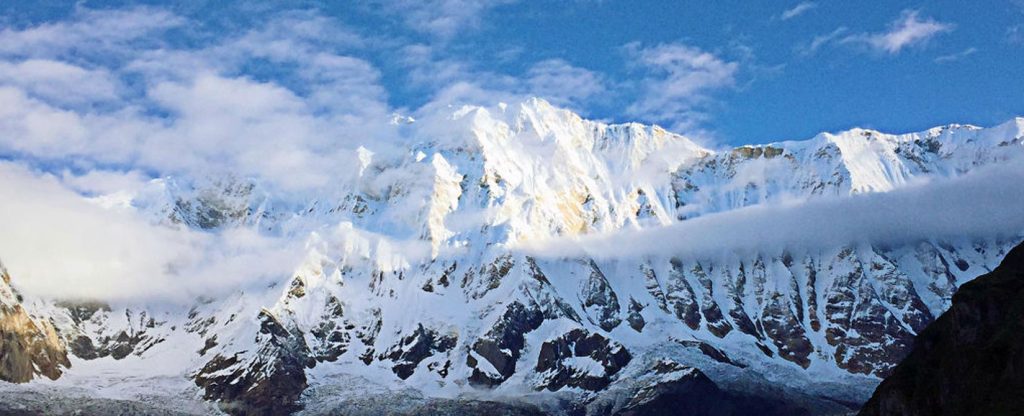
It is widely established that the Nepal Himalaya’s peak times are October–November and March, and April. However, trekking during the less busy season has its advantages. There are two recognized off-peak seasons for trekking in Nepal – the winter and the monsoon. The benefits of going on a trek during the low season. The trails won’t be busy with other trekkers, and you won’t have queues to shower at the lodge. Sometimes you could be the only trekker in the hostel. Trekking during the off-season is my favourite period. Trekking during December, January, and February. The colder winter months mean the clouds rise later to cover the beautiful mountains that Nepal is famous for. Winter is often the clearest time of year due to the colder temperatures. Sometimes the hills stay visible for days on end. Won’t it be cold, and what about snowfall? It can be crisp to cold in the mornings, depending on how high you are. However, you will warm up as soon as you start your day’s hike; you could even be sweating while walking. Have warm layers of clothing in your daypack to layer up when you stop for lunch or at the end of the day. In the evenings, the lodge owners light up the heater in the dining, which should keep you nice and toasty. We receive precipitation a few days every month except during the monsoon, when it rains more frequently. You might get snowfall in the higher altitudes, usually above 3000 meters, but it melts away in a couple of days. You might think to be at the base of the world’s highest mountains; snow could cover the trails and make it risky to trek. Remember that Nepal’s latitude is similar to Cairo and Miami, which is not too far north of the equator, making it much less cold than Europe or North America. You would still have to be careful when you come across frozen streams and might encounter icy parts on the trail early in the mornings or where the sun doesn’t shine much. Believe it or not, Nepal receives more snowfall during spring than winter. Therefore, an added benefit of winter trekking is that you will burn more calories as your body keeps you warm. Trekking in Nepal during May and June It can be pretty hot in the lower elevations of your trek, but it starts being more refreshing and pleasant as you gain altitude. If you are going to a height above 4500 meters, you will see many flowers in bloom, and it is green everywhere. You will also see beautifully colourful moths of all sizes during these months. Another benefit of this trekking during May and June will be burning calories; as it is warmer, you will sweat more, which means detoxification. Trekking will lack other trekkers and no queues to go through narrow trails or cross bridges during the end of the season’s most significant benefit. You will feel like you have the hills entirely to yourselves at times. You will walk through peaceful villages and their farmland, take your time to stop to observe the villagers go about their daily lives, and photograph them. Don’t be surprised if you are the only one at some lodges. The lodge owners won’t be as busy as during the peak season; some like to mingle with you. You could learn about their lifestyle, ask them how tourism has helped them, etc. This could be the beginning of a new friendship. If you are travelling with a small group, you can have leisurely meals, chat, and discuss other trekkers without being self-conscious. Weather Patterns The weather is the most significant concern for those planning to trek during the off-season. The weather in the mountains is unpredictable – more so these days with the effects of global warming. You can be fortunate to see glimpses of the majestic peaks even during May and June. There have been some years when severe weather has affected Lukla or Jomsom’s flights for up to a week during the best times of October and November. I led two treks in July 2017 – one to Helambu and one to Annapurna Base Camp. The Helambu trek was great because we barely saw a total of 10 other trekkers for the entire seven days we were there. We often had lodges to ourselves. The lodge owners were grateful for the income we brought to them during the off-peak season. Unfortunately, we didn’t get to see any snow-clad Peaks. It rained on us for some part of the days – mainly during the afternoons. It rained on us a few days during the monsoon trek to Annapurna Base camp. However, when we were at Machapuchare and Annapurna base camp, the clouds opened up, and we were rewarded with stunning views of the mountains. Unlike in Helambu, we were surprised by how busy the trek to Annapurna Base camp was. As mentioned before, the weather in the mountains is unpredictable. Hundreds of flowers also greeted us, and we enjoyed eating wild herbs and vegetables that only grow during the monsoon season. The scenery was lush green on both these treks. While trekking during the summer months, you will see farmers working their land or crops growing on their farmland and wake up to the song of birds in the morning. Can’t trek during the peak season? Don’t despair if you can take time off to trek during the peak season. You can avoid the crowds and have the trail, hills, and lodges to yourself. Consider visiting Nepal to do a hike during the off-season months of December, January, May, and June or even during the monsoon months of July and August. Mother Nature is always beautiful; we must find positive aspects of what lies in front of us. As the saying goes – “If life gives you lemons – make lemonade.” Happy trekking! Do I get a discount when I go trekking during the offseason? The answer is no. You don’t get discounts when you go trekking during the offseason
Am I too old to go trekking in the Himalayas?
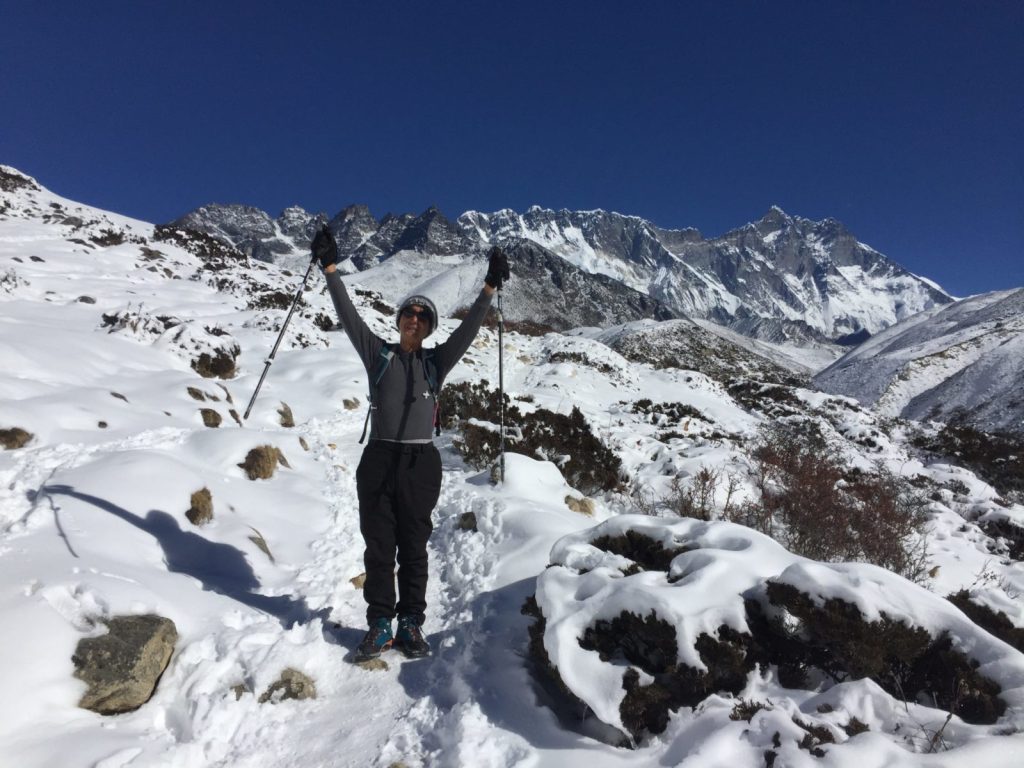
It is a great healthy lifestyle if you have been hiking/trekking or any form of exercise. However, if you haven’t already done it, you are not the only one!
A wedding in remote Nepal
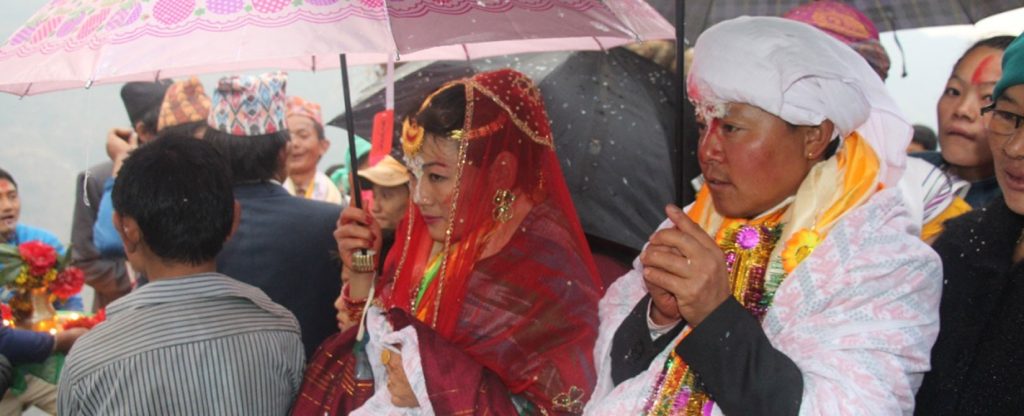
Attending a wedding in remote Nepal We recently concluded a trek to remote Sotang Village Municipality’s village to attend and financially support the wedding of our dear and longest-serving staff Chandra and his bride Manku Rai. We had planned it so our previous and new customers could experience cultural immersion by attending a wedding in Real Nepal ? away from the touristy places 99% of the visitors to Nepal go to. The whole wedding experience was planned for a week. The joining date of the trip coincided with Valentine’s Day. We had four overseas participants ? an Australian couple who have done two treks with Chandra; two Singaporeans ? one who has done several treks with the groom, and the other who has made three trips with us. The Journey to the Wedding. We had a long drive towards Salleri on the second day. We drove on a winding road along the Sun Koshi River until we reached Harkapur of Okhadhunga district, where we started ascending. Despite the relatively short distance and good road conditions, it took us longer than expected. Being stuck for forty-five minutes in a traffic jam in Kathmandu didn’t help. We had a team discussion and decided to stay at Patale for the night. Upon reaching Patale, we checked out the rooms, which were basic but neat and clean; we ordered some refreshing black tea and Dal bhat (Nepalese staple diet) for dinner. It was a cold but clear night at 2875 meters, with stars shining brightly as there were no light disturbances. We had an early night so we could have an early start. The following day was clear, and we took the wedding participants for a surprise view of Mount Everest and other giant Himalayan Peaks before breakfast. After that, we headed for Salleri, the district administrative centre for Solu Khumbu district; the jeep got refuelled. We left the blacktopped road a short distance after refuelling, and the bone-wrenching journey to Sotang began. However, the scenery made the rough drive somewhat bearable. It took us about three hours to reach the Dudh Koshi River before the last leg to Sotang Bazaar. The River was only made possible to cross from the previous winter with a temporary “bridge” built over it. The final 5 km was the most challenging part of the journey, where some passengers had to descend at a few places so the jeep could manoeuvre over steep dirt road sections. The 5km drive took us ninety minutes. Once we reached Sotang Bazaar, we went to our staff Sundar’s “hotel” to have our preordered lunch while our seven porters were busy offloading our camping gear from the jeep and divided it into equal loads. We had a two and half hour hike to Majh Kharka ? the groom’s village. The walk was relatively comfortable, with a small ascend for about forty-five minutes to the top of the hill. The trail then became short descents, undulating before we started a short climb to the groom’s home. Chandra eagerly awaited our arrival; his family members warmly welcomed us. Our porters arrived shortly after us; they and our support team got busy setting up our tents on the local “Youth Club grounds.” We were invited to dinner with the groom’s family, as they were ‘free’ before the wedding rush began the following day. Once our campsite was ready, we set our respective tents up and got ready for the evening. The Rai ethnic group and their traditions Chandra belongs to the Kirat ethnic group of the Rai and Limbu communities, with numerous clans and sub-clans. The Kirats are some of the first recorded people to have ruled Kathmandu in Nepal’s history. They practice a mixture of ancient animistic religions worshipping the forests, rocks, rivers, and everything to do with nature and some Hindu rituals. The most important part of their diet is pork ? every household rears a pig for special occasions. They also love their alcoholic drinks, namely Chang ? fermented grains, but millet is their grain of choice, which they drink instead of water and Rakshi ? distilled homemade liquor from fermented millet. Alcohol is consumed in all their essential rituals. Pre-wedding family dinner We went into the ‘kitchen’ of the family, where a fireplace is set in the middle with four poles on each corner ? an essential part of the Rai ethnic group’s traditions. Unique places are set for the elders according to their importance in the family. We were invited to sit with the family members and were served Rakshi ? their homemade liquor. Culture and traditions were explained to the guests. It appeared that their weddings were very well organized with various chores/duties assigned to a different set of people ? mostly all relatives. It starts with a guy who estimates the whole wedding budget; I jokingly called him the CFO, a team each for making Chang, Rakshi, purchasing, cooking, the sisters and female cousins were in charge or serving alcohol to all present ? they made sure everyone had plenty. So we had plenty to drink and a good dinner of pork curry and rice. We went to bed feeling relaxed after the consumption of rakshi despite the bone-wrenching ride that morning. Final preparation day We were woken up with an ayurvedic drink delivered to our tents. This drink is excellent as it has anti-inflammatory properties, provides exceptional energy, and gets rid of cancerous cells. One of our host’s cousins had kindly invited us for breakfast. The morning activities consisted of going for breakfast, having tea with another of our host’s cousins, and visiting the local school to watch a pig’s ritual killing before lunch. Our overseas guests were treated to an excellent and healthy meal prepared by our trekking chefs while we went for lunch at a relative’s home. The villagers are so hospitable and accommodating. We were invited to many of their homes for tea and meals; sadly, we couldn’t visit every house that welcomed us.
Corporate Social Responsibility of an adventure tour operator in Nepal
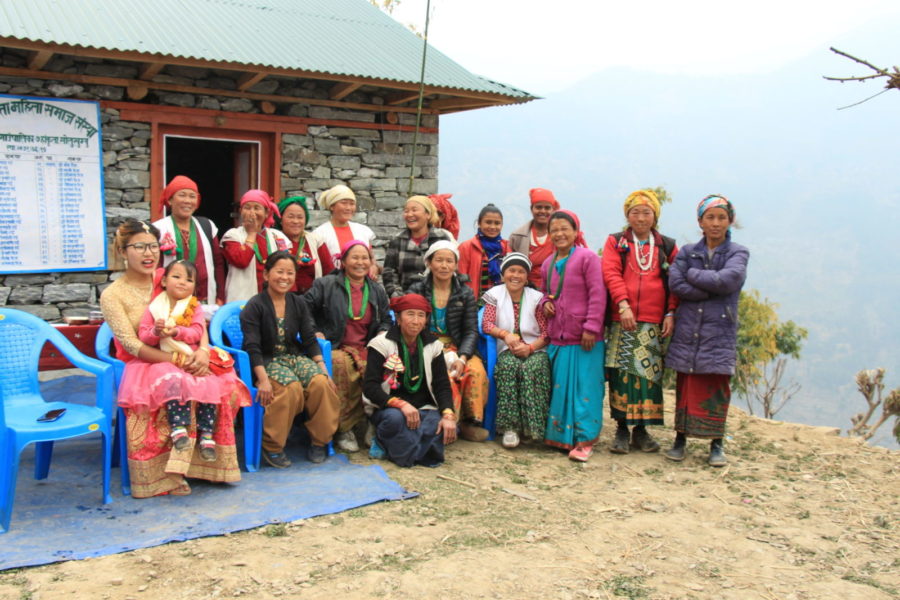
Our founder, Rajesh Kumar Tamang, aka Raj, believes Charity begins at home. He says our biggest asset is our staff: happy porters, talented support crew, trekking chefs, and expert trek leaders. He says, “We value our staff highly.. after all, happy staff makes happy customers! We have handpicked and trained our field staff, who are experts in their duties to make your trek enjoyable.” Responsible Adventures is committed to a fair-trade approach and practice, namely Genuine Responsible Tourism. Providing our staff with a dignified working environment is of utmost importance. We pay our team a generous wage to help them improve their lives for themselves and their families. Another aspect of our CSR is making sure most of your money will benefit the region and the people you are trekking with. Despite being a relatively small company, we have set high standards and integrity. Our handpicked and highly trained employees can proudly say that we provide excellent value for money and unparalleled trekking services in the Himalayas. Looking beyond our company walls, Raj has been volunteering as an instructor of Wilderness and Advanced Wilderness First Aid training to teach Trek leaders and trekking guides of international tour operators since 2011. After the massive earthquake in April and May 2015, Raj helped Non-profit organisations by providing his employees as volunteers to help bring relief materials to affected villages in certain parts of Nepal. He has volunteered to educate children on the policies of leaving no trace on hiking trips. Instead, he teaches the children to leave nothing but footsteps and take nothing but the appreciation of nature. In December 2015, he went to the remote villages of Solu Khumbu, where most of his employees come from, with some donations to help partially with the maintenance and construction of schools. Raj has volunteered as a “Medic” for outdoor events, such as the Nepal NCA Mountain Bike Championship on March 19th, 2016. In addition, Bhote Koshi expresses a kayak competition from October 25th until October 29th and the Kathmandu Mountain Bike Festival from the 18th to the 20th of October 2016.










